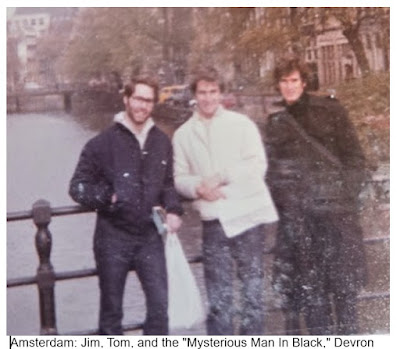After whirlwind visits to New York, London, Copenhagen, Oslo, Bergen, and Amsterdam, the boys were tired. Embracing their new traveling mantra, “Be flexible,” they took another look at their planned itinerary, which called for them to head into the heart of Germany. But Tom and Jim agreed that it might be a nice break to find a smaller, Flam-like town to recharge their batteries.
Tom pulled out his dog-eared Let’s Go Europe and one of his maps, falling apart from multiple re-foldings.“Here’s one—Enkhuizen,” Tom said. “It’s on the Zuider Zee.”
That sparked Jim’s attention and fond memories of reading about Hans Brinker, the Silver Skates, and the boy who plugged a dike with his finger.
Located about 40 miles northeast of Amsterdam, Enkhuizen sits on the shores of Ijsselmeer and Markermeer lakes. For most of its history, which as a city started in 1356, Enkhuizen was an important harbor on the Zuiderzee and a major trading hub for the Dutch East India Company. At one time, it had the largest herring fleet in the Netherlands and for a long time was known as “Herring Town.”
Upon reading
this (aloud, per usual), Tom envisioned a fishing village, with boats,
seagulls, and women on the docks, waiting for their husbands to return home
from the open seas with the day’s catch.
More reading
revealed that although for centuries it played a prominent role in the herring
fishing industry, the city now focuses on other economic sectors—water sports
being one of its most popular and profitable. But what struck Tom and Jim was
the town’s quiet charm—its cobblestone streets, numerous cafes and restaurants,
and a population of just 10,000 (now closer to 18,000).
One of Enkhuizen’s major attractions, then
and now, is the Drommedaris, a 15th-century fortress and bell tower.
Back when Tom and Jim visited, its upper floor, once a
prison, had been converted into budget lodging. For just 6 guilders—about
$2.50—they could toss their sleeping bags down in the large open space. The
tower also housed a 44-bell carillon—which nearly knocked them off their feet
when they chimed as they dropped off their backpacks.
They had arrived early in the day, so after stashing their
backpacks, they rented bikes (just 5 guilders for the day) and set off. They
pedaled along the canals and into the countryside, where even the ducks and
swans, it seemed to Tom, waddled up to say hello. As with the small village of Hilton in
England, Enkhuizen struck them as the perfect storybook setting.
That
feeling only deepened in the early evening as they walked the cobblestone
streets. The houses were lovingly tended—flower boxes on the windows, small
gardens in neat plots, lace curtains pulled back even at night. You could peer
in and see families gathered at supper. Bells rang constantly from the
Drommedaris, the local church, and the town hall. Children played in the park.
It all felt like a brief step into utopia. Nothing to fear in Enkhuizen.
That night,
they were surprised to see that no other backpackers had checked in, and they
had the entire third floor of the Drommedaris to themselves. All that space—atop
a former fortress and prison—was fitting. It was Halloween night. Spooky. And it gave them a taste of what a late-October
night felt like inside a drafty 15th-century building.
Tom and Jim spent Halloween '77 as lone hostelers atop the 15th-century fortress, Drommedaris. (Photo (c) Drombar)
The next morning,
Tom and Jim continued their exploration of the town. As they descended from the
third floor, they discovered that the other floors were used for various local activities
and cultural events. That particular morning featured a fencing match. The boys
sat and watched for a while, not knowing the sport but enjoying the cheers that
erupted with each sudden thrust and parry.
They also visited
the Enkhuizen cemetery, where many of the gravestones marked the resting places
of men and women their age—or younger—casualties of WWII. They also visited the
Tomb of the Unknown Soldiers. Known Unto God. They both reflected once
again on the incongruity of the horrible events that took place in this now
quiet and peaceful place.
Before catching
another overnight train, they walked once more along the canals, past cobblestone
alleys, windmills, red-roofed row houses with furniture hoists. This, Tom
remarked, was how life should be lived. As night fell, this feeling
deepened as they could easily see scenes of domestic tranquility.
From Jim’s journal: Walking in the cold wind and looking in
the windows of the small cottages, so close to the sidewalk/street. A woman in
a chair, legs tucked beneath her, head tilted, asleep. A man in a chair in a
corner, reading. A child? Maybe. Warm.
From Tom’s
journal: The streets,
the houses, the friendliness, the shops, the canals, the bicycles, the nightly
walks, the bells, the children, the flowered parks, the smell of the bakeries,
the water always nearby, the use of cycles, the windmills, the fine weather,
the small local pubs serving the sausage and cheese you want and top off with a
Heineken. Just needed a town crier!
It was another
extended “Moment of Nirvana” for the two Overlanders. But Germany—and beyond—beckoned.
###
And now for the NOW. Reflections on Enkhuizen:





